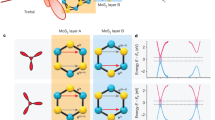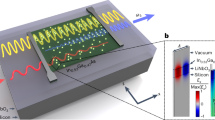Abstract
Parametric nonlinear optical processes are at the heart of nonlinear optics underpinning the central role in the generation of entangled photons as well as the realization of coherent optical sources. Exciton-polaritons are capable to sustain parametric scattering at extremely low threshold, offering a readily accessible platform to study bosonic fluids. Recently, two-dimensional transition-metal dichalcogenides (TMDs) have attracted great attention in strong light–matter interactions due to robust excitonic transitions and unique spin-valley degrees of freedom. However, further progress is hindered by the lack of realizations of strong nonlinear effects in TMD polaritons. Here, we demonstrate a realization of nonlinear optical parametric polaritons in a WS2 monolayer microcavity pumped at the inflection point and triggered in the ground state. We observed the formation of a phase-matched idler state and nonlinear amplification that preserves the valley population and survives up to room temperature. Our results open a new door towards the realization of the future for all-optical valley polariton nonlinear devices.
This is a preview of subscription content, access via your institution
Access options
Access Nature and 54 other Nature Portfolio journals
Get Nature+, our best-value online-access subscription
$29.99 / 30 days
cancel any time
Subscribe to this journal
Receive 12 print issues and online access
$259.00 per year
only $21.58 per issue
Buy this article
- Purchase on Springer Link
- Instant access to full article PDF
Prices may be subject to local taxes which are calculated during checkout




Similar content being viewed by others
Data availability
All data needed to evaluate the conclusions in the paper are present in the main text and/or the Supplementary Information. Additional data related to this paper may be requested from the authors on reasonable request.
References
Savvidis, P. et al. Angle-resonant stimulated polariton amplifier. Phys. Rev. Lett. 84, 1547 (2000).
Saba, M. et al. High-temperature ultrafast polariton parametric amplification in semiconductor microcavities. Nature 414, 731–735 (2001).
Roslund, J., De Araujo, R. M., Jiang, S., Fabre, C. & Treps, N. Wavelength-multiplexed quantum networks with ultrafast frequency combs. Nat. Photonics 8, 109–112 (2014).
Marandi, A., Wang, Z., Takata, K., Byer, R. L. & Yamamoto, Y. Network of time-multiplexed optical parametric oscillators as a coherent Ising machine. Nat. Photonics 8, 937–942 (2014).
Weisbuch, C., Nishioka, M., Ishikawa, A. & Arakawa, Y. Observation of the coupled exciton-photon mode splitting in a semiconductor quantum microcavity. Phys. Rev. Lett. 69, 3314–3317 (1992).
Kasprzak, J. et al. Bose–Einstein condensation of exciton polaritons. Nature 443, 409–414 (2006).
Sanvitto, D. & Kéna-Cohen, S. The road towards polaritonic devices. Nat. Mater. 15, 1061–1073 (2016).
Balili, R., Hartwell, V., Snoke, D., Pfeiffer, L. & West, K. Bose-Einstein condensation of microcavity polaritons in a trap. Science 316, 1007–1010 (2007).
Zhao, J. et al. Ultralow threshold polariton condensate in a monolayer semiconductor microcavity at room temperature. Nano Lett. 21, 3331–3339 (2021).
Amo, A. et al. Superfluidity of polaritons in semiconductor microcavities. Nat. Phys. 5, 805–810 (2009).
Amo, A. et al. Collective fluid dynamics of a polariton condensate in a semiconductor microcavity. Nature 457, 291–295 (2009).
Leyder, C. et al. Interference of coherent polariton beams in microcavities: polarization-controlled optical gates. Phys. Rev. Lett. 99, 196402 (2007).
Ballarini, D. et al. All-optical polariton transistor. Nat. Commun. 4, 1778 (2013).
Marsault, F. et al. Realization of an all optical exciton-polariton router. Appl. Phys. Lett. 107, 201115 (2015).
Baumberg, J. et al. Parametric oscillation in a vertical microcavity: a polariton condensate or micro-optical parametric oscillation. Phys. Rev. B. 62, R16247 (2000).
Kundermann, S. et al. Coherent control of polariton parametric scattering in semiconductor microcavities. Phys. Rev. Lett. 91, 107402 (2003).
Sanvitto, D. et al. Spatial structure and stability of the macroscopically occupied polariton state in the microcavity optical parametric oscillator. Phys. Rev. B. 73, 241308 (2006).
Christmann, G. et al. Control of polariton scattering in resonant-tunneling double-quantum-well semiconductor microcavities. Phys. Rev. B. 82, 113308 (2010).
Ardizzone, V. et al. Formation and control of turing patterns in a coherent quantum fluid. Sci. Rep. 3, 3016 (2013).
Díaz-Camacho, G., Tejedor, C. & Marchetti, F. Spontaneous patterns in coherently driven polariton microcavities. Phys. Rev. B. 97, 245309 (2018).
Glazov, M. et al. Polariton-polariton scattering in microcavities: a microscopic theory. Phys. Rev. B. 80, 155306 (2009).
Sanvitto, D. et al. Persistent currents and quantized vortices in a polariton superfluid. Nat. Phys. 6, 527–533 (2010).
Krizhanovskii, D. et al. Effect of interactions on vortices in a nonequilibrium polariton condensate. Phys. Rev. Lett. 104, 126402 (2010).
Marchetti, F., Szymańska, M., Tejedor, C. & Whittaker, D. Spontaneous and triggered vortices in polariton optical-parametric-oscillator superfluids. Phys. Rev. Lett. 105, 063902 (2010).
Xie, W. et al. Room-temperature polariton parametric scattering driven by a one-dimensional polariton condensate. Phys. Rev. Lett. 108, 166401 (2012).
Daskalakis, K., Maier, S., Murray, R. & Kéna-Cohen, S. Nonlinear interactions in an organic polariton condensate. Nat. Mater. 13, 271–278 (2014).
Plumhof, J. D., Stöferle, T., Mai, L., Scherf, U. & Mahrt, R. F. Room-temperature Bose–Einstein condensation of cavity exciton–polaritons in a polymer. Nat. Mater. 13, 247–252 (2014).
Su, R. et al. Room-temperature polariton lasing in all-inorganic perovskite nanoplatelets. Nano Lett. 17, 3982–3988 (2017).
Lerario, G. et al. Room-temperature superfluidity in a polariton condensate. Nat. Phys. 13, 837–841 (2017).
Fieramosca, A. et al. Two-dimensional hybrid perovskites sustaining strong polariton interactions at room temperature. Sci. Adv. 5, eaav9967 (2019).
Wu, J. et al. Nonlinear parametric scattering of exciton polaritons in perovskite microcavities. Nano Lett. 21, 3120–3126 (2021).
Mak, K. F., He, K., Shan, J. & Heinz, T. F. Control of valley polarization in monolayer MoS2 by optical helicity. Nat. Nanotechnol. 7, 494–498 (2012).
Wang, Q. H., Kalantar Zadeh, K., Kis, A., Coleman, J. N. & Strano, M. S. Electronics and optoelectronics of two-dimensional transition metal dichalcogenides. Nat. Nanotechnol. 7, 699–712 (2012).
Schaibley, J. R. et al. Valleytronics in 2D materials. Nat. Rev. Mater. 1, 16055 (2016).
Liu, X. et al. Strong light–matter coupling in two-dimensional atomic crystals. Nat. Photonics 9, 30–34 (2015).
Chen, Y.-J., Cain, J. D., Stanev, T. K., Dravid, V. P. & Stern, N. P. Valley-polarized exciton–polaritons in a monolayer semiconductor. Nat. Photonics 11, 431–435 (2017).
Dufferwiel, S. et al. Valley-addressable polaritons in atomically thin semiconductors. Nat. Photonics 11, 497–501 (2017).
Sun, Z. et al. Optical control of room-temperature valley polaritons. Nat. Photonics 11, 491–496 (2017).
Zhang, L., Gogna, R., Burg, W., Tutuc, E. & Deng, H. Photonic-crystal exciton-polaritons in monolayer semiconductors. Nat. Commun. 9, 713 (2018).
Lundt, N. et al. Optical valley Hall effect for highly valley-coherent exciton-polaritons in an atomically thin semiconductor. Nat. Nanotechnol. 14, 770–775 (2019).
Qiu, L., Chakraborty, C., Dhara, S. & Vamivakas, A. Room-temperature valley coherence in a polaritonic system. Nat. Commun. 10, 1513 (2019).
Trovatello, C. et al. Optical parametric amplification by monolayer transition metal dichalcogenides. Nat. Photonics 15, 6–10 (2021).
Barachati, F. et al. Interacting polariton fluids in a monolayer of tungsten disulfide. Nat. Nanotechnol. 13, 906–909 (2018).
Kravtsov, V. et al. Nonlinear polaritons in a monolayer semiconductor coupled to optical bound states in the continuum. Light: Sci. Appl. 9, 56 (2020).
Emmanuele, R. et al. Highly nonlinear trion-polaritons in a monolayer semiconductor. Nat. Commun. 11, 3286 (2020).
Tan, L. B. et al. Interacting polaron-polaritons. Phys. Rev. 10, 021011 (2020).
Waldherr, M. et al. Observation of bosonic condensation in a hybrid monolayer MoSe2-GaAs microcavity. Nat. Commun. 9, 3286 (2018).
Gu, J., Chakraborty, B., Khatoniar, M. & Menon, V. M. A room-temperature polariton light-emitting diode based on monolayer WS2. Nat. Nanotechnol. 14, 1024–1028 (2019).
Gu, J. et al. Enhanced nonlinear interaction of polaritons via excitonic Rydberg states in monolayer WSe2. Nat. Commun. 12, 2269 (2021).
Zhang, L. et al. van der Waals heterostructure polaritons with moiré-induced nonlinearity. Nature 591, 61–65 (2021).
Rupprecht, C. et al. Micro-mechanical assembly and characterization of high-quality Fabry–Pérot microcavities for the integration of two-dimensional materials. Appl. Phys. Lett. 118, 103103 (2021).
Liu, X. et al. Control of coherently coupled exciton polaritons in monolayer tungsten disulphide. Phys. Rev. Lett. 119, 027403 (2017).
Keeling, J. & Berloff, N. G. Spontaneous rotating vortex lattices in a pumped decaying condensate. Phys. Rev. Lett. 100, 250401 (2008).
Shelykh, I. et al. Non-linear coupling of polariton and dark exciton states in semiconductor microcavities. Solid State Commun. https://doi.org/10.1016/j.ssc.2005.04.012 (2005).
Cerna, R. et al. Ultrafast tristable spin memory of a coherent polariton gas. Nat. Commun. 4, 2008 (2013).
Grosso, G. et al. Nonlinear relaxation and selective polychromatic lasing of confined polaritons. Phys. Rev. B. 90, 045307 (2014).
Acknowledgements
We acknowledge the following funding sources: National Natural Science Foundation of China under grant no. 12020101003 and funding support from State Key Laboratory of Low-Dimensional Quantum Physics of Tsinghua University (Q.X.); Singapore Ministry of Education via the AcRF Tier 3 Programme ‘Geometrical Quantum Materials’ and AcRF Tier 2 project under grant nos. MOE2018-T3-1-002 and MOE2018-T2-2-068 (T.C.H.L.). Ministry of Education, University and Research of Italy via the PRIN project ‘Interacting Photons in Polariton Circuits—INPhoPOL’, FISR-COVID project ‘Wavesense’ and Joint Bilateral Agreement CNR-RFBR (Russian Foundation for Basic Research) project `Hardware implementation of a polariton neural network for neuromorphic computing`, Triennal Program 2021–2023, under grant nos. 2017P9FJBS_001 and FISR2020IP_04324 (D.S.).
Author information
Authors and Affiliations
Contributions
A.F. and J.Z. conceived the ideas and designed the experiments. J.Z. prepared the monolayer microcavity samples with the help of W.D., R.S., J.F. and Y.L. A.F. and J.Z. carried out the optical spectroscopy measurements and analysed data. R.B. performed the theoretical calculations with the help of K.D. J.Z., A.F., T.C.H.L., D.S. and Q.X. wrote the manuscript with input from all authors. Q.X. supervised the whole project.
Corresponding authors
Ethics declarations
Competing interests
The authors declare no competing interests.
Peer review
Peer review information
Nature Nanotechnology thanks Nathaniel Stern and the other, anonymous, reviewer(s) for their contribution to the peer review of this work.
Additional information
Publisher’s note Springer Nature remains neutral with regard to jurisdictional claims in published maps and institutional affiliations.
Supplementary information
Supplementary Information
Supplementary Figs. 1–17.
Rights and permissions
About this article
Cite this article
Zhao, J., Fieramosca, A., Bao, R. et al. Nonlinear polariton parametric emission in an atomically thin semiconductor based microcavity. Nat. Nanotechnol. 17, 396–402 (2022). https://doi.org/10.1038/s41565-022-01073-9
Received:
Accepted:
Published:
Issue Date:
DOI: https://doi.org/10.1038/s41565-022-01073-9
This article is cited by
-
Energy transfer driven brightening of MoS2 by ultrafast polariton relaxation in microcavity MoS2/hBN/WS2 heterostructures
Nature Communications (2024)
-
Exciton polariton interactions in Van der Waals superlattices at room temperature
Nature Communications (2023)
-
Macroscopic transition metal dichalcogenides monolayers with uniformly high optical quality
Nature Communications (2023)
-
Manipulating nonlinear exciton polaritons in an atomically-thin semiconductor with artificial potential landscapes
Light: Science & Applications (2023)
-
Manipulating the nonlinearity of transition-metal dichalcogenide polaritons
Light: Science & Applications (2023)



